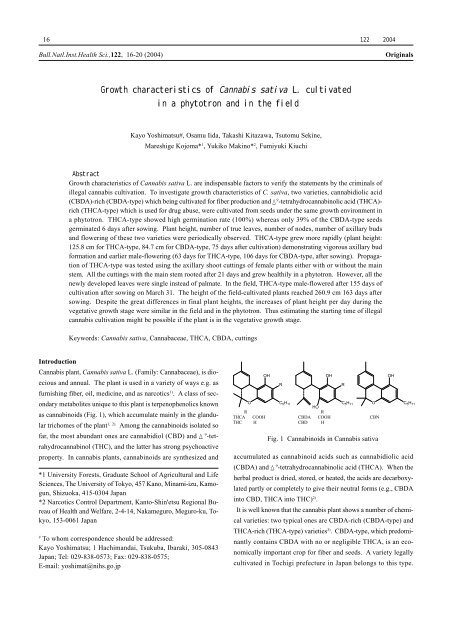Growth characteristics of Cannabis sativa L. cultivated in a ... - NIHS
Growth characteristics of Cannabis sativa L. cultivated in a ... - NIHS
Growth characteristics of Cannabis sativa L. cultivated in a ... - NIHS
You also want an ePaper? Increase the reach of your titles
YUMPU automatically turns print PDFs into web optimized ePapers that Google loves.
16 <br />
Bull.Natl.Inst.Health Sci.,122,16-20 (2004)<br />
Orig<strong>in</strong>als<br />
<br />
<br />
Kayo Yoshimatsu#, Osamu Iida, Takashi Kitazawa, Tsutomu Sek<strong>in</strong>e,<br />
Mareshige Kojoma* 1 , Yukiko Mak<strong>in</strong>o* 2 , Fumiyuki Kiuchi<br />
<br />
<strong>Growth</strong> <strong>characteristics</strong> <strong>of</strong> <strong>Cannabis</strong> <strong>sativa</strong> L. are <strong>in</strong>dispensable factors to verify the statements by the crim<strong>in</strong>als <strong>of</strong><br />
illegal cannabis cultivation. To <strong>in</strong>vestigate growth <strong>characteristics</strong> <strong>of</strong> C. <strong>sativa</strong>, two varieties, cannabidiolic acid<br />
(CBDA)-rich (CBDA-type) which be<strong>in</strong>g <strong>cultivated</strong> for fiber production and 9 -tetrahydrocannab<strong>in</strong>olic acid (THCA)-<br />
rich (THCA-type) which is used for drug abuse, were <strong>cultivated</strong> from seeds under the same growth environment <strong>in</strong><br />
a phytotron. THCA-type showed high germ<strong>in</strong>ation rate (100%) whereas only 39% <strong>of</strong> the CBDA-type seeds<br />
germ<strong>in</strong>ated 6 days after sow<strong>in</strong>g. Plant height, number <strong>of</strong> true leaves, number <strong>of</strong> nodes, number <strong>of</strong> axillary buds<br />
and flower<strong>in</strong>g <strong>of</strong> these two varieties were periodically observed. THCA-type grew more rapidly (plant height:<br />
125.8 cm for THCA-type, 84.7 cm for CBDA-type, 75 days after cultivation) demonstrat<strong>in</strong>g vigorous axillary bud<br />
formation and earlier male-flower<strong>in</strong>g (63 days for THCA-type, 106 days for CBDA-type, after sow<strong>in</strong>g). Propagation<br />
<strong>of</strong> THCA-type was tested us<strong>in</strong>g the axillary shoot cutt<strong>in</strong>gs <strong>of</strong> female plants either with or without the ma<strong>in</strong><br />
stem. All the cutt<strong>in</strong>gs with the ma<strong>in</strong> stem rooted after 21 days and grew healthily <strong>in</strong> a phytotron. However, all the<br />
newly developed leaves were s<strong>in</strong>gle <strong>in</strong>stead <strong>of</strong> palmate. In the field, THCA-type male-flowered after 155 days <strong>of</strong><br />
cultivation after sow<strong>in</strong>g on March 31. The height <strong>of</strong> the field-<strong>cultivated</strong> plants reached 260.9 cm 163 days after<br />
sow<strong>in</strong>g. Despite the great differences <strong>in</strong> f<strong>in</strong>al plant heights, the <strong>in</strong>creases <strong>of</strong> plant height per day dur<strong>in</strong>g the<br />
vegetative growth stage were similar <strong>in</strong> the field and <strong>in</strong> the phytotron. Thus estimat<strong>in</strong>g the start<strong>in</strong>g time <strong>of</strong> illegal<br />
cannabis cultivation might be possible if the plant is <strong>in</strong> the vegetative growth stage.<br />
Keywords: <strong>Cannabis</strong> <strong>sativa</strong>, Cannabaceae, THCA, CBDA, cutt<strong>in</strong>gs<br />
Introduction<br />
<strong>Cannabis</strong> plant, <strong>Cannabis</strong> <strong>sativa</strong> L. (Family: Cannabaceae), is dioecious<br />
and annual. The plant is used <strong>in</strong> a variety <strong>of</strong> ways e.g. as<br />
furnish<strong>in</strong>g fiber, oil, medic<strong>in</strong>e, and as narcotics 1) . A class <strong>of</strong> secondary<br />
metabolites unique to this plant is terpenophenolics known<br />
as cannab<strong>in</strong>oids (Fig. 1), which accumulate ma<strong>in</strong>ly <strong>in</strong> the glandular<br />
trichomes <strong>of</strong> the plant 1, 2). Among the cannab<strong>in</strong>oids isolated so<br />
far, the most abundant ones are cannabidiol (CBD) and 9 -tetrahydrocannab<strong>in</strong>ol<br />
(THC), and the latter has strong psychoactive<br />
property. In cannabis plants, cannab<strong>in</strong>oids are synthesized and<br />
*1 University Forests, Graduate School <strong>of</strong> Agricultural and Life<br />
Sciences, The University <strong>of</strong> Tokyo, 457 Kano, M<strong>in</strong>ami-izu, Kamogun,<br />
Shizuoka, 415-0304 Japan<br />
*2 Narcotics Control Department, Kanto-Sh<strong>in</strong>'etsu Regional Bureau<br />
<strong>of</strong> Health and Welfare, 2-4-14, Nakameguro, Meguro-ku, Tokyo,<br />
153-0061 Japan<br />
#<br />
To whom correspondence should be addressed:<br />
Kayo Yoshimatsu; 1 Hachimandai, Tsukuba, Ibaraki, 305-0843<br />
Japan; Tel: 029-838-0573; Fax: 029-838-0575;<br />
E-mail: yoshimat@nihs.go.jp<br />
Fig. 1 Cannab<strong>in</strong>oids <strong>in</strong> <strong>Cannabis</strong> <strong>sativa</strong><br />
accumulated as cannab<strong>in</strong>oid acids such as cannabidiolic acid<br />
(CBDA) and 9 -tetrahydrocannab<strong>in</strong>olic acid (THCA). When the<br />
herbal product is dried, stored, or heated, the acids are decarboxylated<br />
partly or completely to give their neutral forms (e.g., CBDA<br />
<strong>in</strong>to CBD, THCA <strong>in</strong>to THC) 2) .<br />
It is well known that the cannabis plant shows a number <strong>of</strong> chemical<br />
varieties: two typical ones are CBDA-rich (CBDA-type) and<br />
THCA-rich (THCA-type) varieties 3) . CBDA-type, which predom<strong>in</strong>antly<br />
conta<strong>in</strong>s CBDA with no or negligible THCA, is an economically<br />
important crop for fiber and seeds. A variety legally<br />
<strong>cultivated</strong> <strong>in</strong> Tochigi prefecture <strong>in</strong> Japan belongs to this type.
<strong>Growth</strong> <strong>characteristics</strong> <strong>of</strong> <strong>Cannabis</strong> <strong>sativa</strong> L. <strong>cultivated</strong> <strong>in</strong> a phytotron and <strong>in</strong> the field<br />
17<br />
Fig. 2. Photos <strong>of</strong> cannabis plant<br />
A, seeds <strong>of</strong> THCA-rich variety; B, seeds <strong>of</strong> CBDA-rich variety; C, phytotron grown THCA-rich plants; D, phytotron grown CBDArich<br />
plants; E, a s<strong>in</strong>gle leaf formed on the THCA-rich plant grown from cutt<strong>in</strong>g. A, B: scale shows 1 mm. C, D: 75 days from<br />
sow<strong>in</strong>g. E: 94 days from cutt<strong>in</strong>g.<br />
THCA-type, which predom<strong>in</strong>antly accumulates THCA, is socalled<br />
'drug type' and <strong>cultivated</strong> for illegal use. The products <strong>of</strong><br />
THCA-type are one <strong>of</strong> the most widely abused illicit drugs <strong>in</strong> the<br />
world and illegal cultivation <strong>of</strong> the plants poses social problems.<br />
In Japan, the plant is illegally <strong>cultivated</strong> <strong>in</strong>door as well as outdoor<br />
though the <strong>Cannabis</strong> Control Act prohibits its cultivation and possession.<br />
Crim<strong>in</strong>al <strong>in</strong>vestigations <strong>of</strong> illegal cannabis cultivation<br />
require <strong>in</strong>spection <strong>of</strong> the grow<strong>in</strong>g status. It is significantly important<br />
to reveal when the illegal cultivation started and how the plants<br />
reached to the present growth status <strong>in</strong> the <strong>in</strong>vestigation. Although<br />
many works on identification <strong>of</strong> cannabis by means <strong>of</strong> molecular<br />
biological techniques 4-10) have so far been published, there were<br />
few reports on the growth <strong>characteristics</strong> <strong>of</strong> cannabis varieties. In<br />
this study, growth <strong>characteristics</strong> <strong>of</strong> the two varieties (THCA-type<br />
and CBDA-type) are <strong>in</strong>vestigated under artificial climate conditions.<br />
The growth <strong>of</strong> THCA-rich variety <strong>in</strong> the field was also<br />
studied.<br />
Materials and Methods<br />
Plant material<br />
The Mexican variety (Exp. code #013, THCA-type) and cv. CBDA<br />
(Exp. code #045, CBDA-type) <strong>of</strong> C. <strong>sativa</strong> 7) were used for this<br />
study. In a prelim<strong>in</strong>ary experiment, they were <strong>cultivated</strong> <strong>in</strong> a phytotron<br />
and cannab<strong>in</strong>oids (THCA and CBDA) contents <strong>in</strong> their<br />
leaves were determ<strong>in</strong>ed as described previously 8) . Both types were<br />
used for the growth <strong>in</strong>vestigation <strong>in</strong> a phytotron. For the field<br />
study, the THCA-type was used.<br />
Cultivation <strong>in</strong> a phytotron<br />
The seeds were sown <strong>in</strong> pots (15 cm i.d., soil-leaf mold-Kureha<br />
compost=3:1:1, 6 pots for each variety, 3 seeds/pot) and <strong>cultivated</strong><br />
<strong>in</strong> a phytotron (24 C/14 hr light, 20 C/10 hr dark, 60% relative<br />
humidity). After germ<strong>in</strong>ation, the seedl<strong>in</strong>gs were th<strong>in</strong>ned out<br />
at one plant per pot. Liquid fertilizer (HYPONeX x 500 solution)<br />
was given once a week. Germ<strong>in</strong>ation, plant height, number<br />
<strong>of</strong> true leaves, number <strong>of</strong> nodes, number <strong>of</strong> axillary buds and flow-
18 <br />
er<strong>in</strong>g were periodically observed.<br />
Propagation by cutt<strong>in</strong>gs<br />
The axillary shoot cutt<strong>in</strong>gs <strong>of</strong> female plants (ca. 10 cm <strong>in</strong> length)<br />
both with or without the ma<strong>in</strong> stems were planted <strong>in</strong> soil (12 cm<br />
i.d. pot), and <strong>cultivated</strong> <strong>in</strong> a phytotron as mentioned above.<br />
Field cultivation<br />
The seeds <strong>of</strong> THCA-type were sown 10 cm apart <strong>in</strong> a bed (1.3 m<br />
x 3.7 m), 60 cm ridge width on March 31, 2003. Plant height,<br />
number <strong>of</strong> nodes and flower<strong>in</strong>g were periodically observed. Maximum<br />
length and width <strong>of</strong> the palmate leaf and leaflet, and number<br />
<strong>of</strong> leaflets were determ<strong>in</strong>ed on Aug. 8, 2003.<br />
Results and Discussion<br />
<br />
In a prelim<strong>in</strong>ary experiment, cannab<strong>in</strong>oids contents <strong>in</strong> the leaves<br />
were determ<strong>in</strong>ed. THCA-type conta<strong>in</strong>ed 3.34-7.51% (average<br />
4.76%) dry weight THCA and 0-0.38% dry weight CBDA, whereas<br />
CBDA-type conta<strong>in</strong>ed 5.08% dry weight CBDA without any detectable<br />
THCA. There were differences <strong>in</strong> color and size <strong>of</strong> the<br />
seeds between the THCA-rich and CBDA-rich varieties (Fig. 2A<br />
and B).<br />
The seeds <strong>of</strong> THCA-type were smaller and darker than those <strong>of</strong><br />
CBDA-type. There were also differences <strong>in</strong> germ<strong>in</strong>ation ability.<br />
All the THCA-type seeds germ<strong>in</strong>ated <strong>in</strong> a phytotron while the<br />
germ<strong>in</strong>ation rate <strong>of</strong> CBDA-type was only 39% (Table 1).<br />
Germ<strong>in</strong>ation rate <strong>of</strong> THCA-type was also high <strong>in</strong> a field (83.%).<br />
Table 1. Germ<strong>in</strong>ation and male-flower<strong>in</strong>g <strong>of</strong> cannabis plants<br />
<strong>cultivated</strong> under different environmental conditions<br />
Phytotron conditions: 24 C/14 hr light, 20 C/10 hr dark, and<br />
60% relative humidity. The seeds were sown <strong>in</strong> 2003.<br />
Both varieties grew healthily <strong>in</strong> the phytotron (Fig. 2C and D).<br />
The period to male-flower<strong>in</strong>g <strong>in</strong> the phytotron was 63 days for<br />
THCA-type and 106 days for CBDA-type (Table 1). However,<br />
the period to male-flower<strong>in</strong>g was much longer <strong>in</strong> the field (THCAtype:<br />
155 days). In the field, the daytime length at the time <strong>of</strong><br />
sow<strong>in</strong>g (Mar. 31, 2003) was 12 hr 32 m<strong>in</strong> and it peaked (14 hr 39<br />
m<strong>in</strong>) dur<strong>in</strong>g the summer solstice and then it reduced to 12 hr 57<br />
m<strong>in</strong> at the time <strong>of</strong> male-flower<strong>in</strong>g (Sep. 2, 2003). On the other<br />
hand, the light period was constant at 14 hr <strong>in</strong> the phytotron; that<br />
might be one <strong>of</strong> the reasons for much shorter period to male-flower<strong>in</strong>g<br />
<strong>in</strong> the phytotron.<br />
<strong>Growth</strong> <strong>characteristics</strong> such as plant height, number <strong>of</strong> true<br />
leaves, number <strong>of</strong> nodes and number <strong>of</strong> axillary buds were compared<br />
between THCA-rich and CBDA-rich varieties (Table 2).<br />
All the values <strong>of</strong> the THCA-type were larger than those <strong>of</strong> the<br />
CBDA-type dur<strong>in</strong>g the observation period. The THCA-type plants<br />
grew to an average height <strong>of</strong> 125.8 cm and bore fruits after 75<br />
days <strong>of</strong> cultivation. On the other hand, CBDA-type reached 114.7<br />
cm <strong>in</strong> height and male-flowered after 106 days <strong>of</strong> cultivation. F<strong>in</strong>al<br />
numbers <strong>of</strong> true leaves (38.0) and nodes (21.0) <strong>of</strong> CBDA-type<br />
were comparable to those <strong>of</strong> THCA-type (37.7 and 20.8, respectively).<br />
However, there was significant difference <strong>in</strong> axillary bud<br />
formation (24.0 for THCA-type and 17.5 for CBDA-type). These<br />
growth and germ<strong>in</strong>ation differences between the two varieties<br />
might be attributed to the genetic variation that has been reported<br />
previously 6-8, 10) .<br />
Propagation by cutt<strong>in</strong>gs<br />
'Drug type' (THCA-rich variety) plants have been experimentally<br />
propagated by cutt<strong>in</strong>gs 11) . As female plants are <strong>of</strong> importance for<br />
drug production 1) , the axillary shoot cutt<strong>in</strong>gs <strong>of</strong> female THCAtype<br />
were prepared and planted <strong>in</strong> soil. Root<strong>in</strong>g rates <strong>of</strong> the cutt<strong>in</strong>gs<br />
either with or without the ma<strong>in</strong> stem are shown <strong>in</strong> Table 3.<br />
Plant establishment <strong>of</strong> the cutt<strong>in</strong>gs with the ma<strong>in</strong> stem was much<br />
easier than those without the ma<strong>in</strong> stem. The plant heights are<br />
presented <strong>in</strong> Table 4.<br />
After 94 days, the plants derived from cutt<strong>in</strong>gs without the ma<strong>in</strong><br />
Table 2. <strong>Growth</strong> <strong>of</strong> cannabis plants <strong>in</strong> a phytotron<br />
a)<br />
THCA-type, b) CBDA-type<br />
The data are shown as mean standard deviation (n=6).<br />
Phytotron conditions: 24 C/14 hr light, 20 C/10 hr dark, and 60% relative humidity
<strong>Growth</strong> <strong>characteristics</strong> <strong>of</strong> <strong>Cannabis</strong> <strong>sativa</strong> L. <strong>cultivated</strong> <strong>in</strong> a phytotron and <strong>in</strong> the field<br />
19<br />
Table 3. Root<strong>in</strong>g (%) <strong>of</strong> cannabis cutt<strong>in</strong>gs<br />
Table 4. Plant height (cm) <strong>of</strong> the female THCA-type plants<br />
propagated by cutt<strong>in</strong>gs<br />
Cutt<strong>in</strong>gs <strong>of</strong> female plants (ca. 10 cm) were planted <strong>in</strong> soil and<br />
<strong>cultivated</strong> <strong>in</strong> a phytotron under the same conditions as mentioned<br />
above.<br />
The data are shown as mean standard deviation.<br />
Table 5. <strong>Growth</strong> <strong>of</strong> THCA-type cannabis plants <strong>in</strong> the field<br />
The data are shown as mean standard deviation (n=10).<br />
Sow<strong>in</strong>g date: Mar. 31, 2003<br />
Table 6. Comparison <strong>of</strong> growth rate <strong>of</strong> THCA-type grown <strong>in</strong> a<br />
phytotron and <strong>in</strong> the field<br />
Table 7. The size <strong>of</strong> THCA-type cannabis leaves <strong>in</strong> the field<br />
The data (n=10) were recorded on Aug. 8, 2003.<br />
stem demonstrated higher average plant height though the standard<br />
deviation was larger than the plants derived from the cutt<strong>in</strong>gs<br />
with the ma<strong>in</strong> stem. Female flowers were observed <strong>in</strong> all<br />
the plants grown from cutt<strong>in</strong>gs from the early growth stage. In<br />
addition, the newly developed leaves were alternate and s<strong>in</strong>gle<br />
<strong>in</strong>stead <strong>of</strong> palmate (Fig. 2E). The plants grown from the cutt<strong>in</strong>gs<br />
were <strong>in</strong> reproduction stage; that might be a reason for the alternated<br />
s<strong>in</strong>gle leaves, because most <strong>of</strong> nutrition might have been<br />
consumed for their reproduction. Poll<strong>in</strong>ation <strong>of</strong> the female flowers<br />
on vegetatively-propagated THCA-type plants with the pollens<br />
<strong>of</strong> CBDA-type gave seeds as reported previously 2) .<br />
<strong>Growth</strong> <strong>of</strong> THCA-type <strong>in</strong> the field<br />
The THCA-type was <strong>cultivated</strong> <strong>in</strong> the field from seeds. <strong>Growth</strong><br />
parameters <strong>of</strong> the plants are shown <strong>in</strong> Table 5. Increase <strong>of</strong> plant<br />
height and number <strong>of</strong> nodes were most obvious between May and<br />
June. Among thirty plants <strong>cultivated</strong> <strong>in</strong> the field, 25 plants were<br />
female (83.3%). F<strong>in</strong>al plant height on Sep. 10, 2003 was 259.7 <br />
20.0 cm for the male plant and 261.4 32.6 cm for the female<br />
plant. Despite the great differences <strong>in</strong> f<strong>in</strong>al plant height (average<br />
260.9 cm <strong>in</strong> the field and 125.8 cm <strong>in</strong> the phytotron, Tables 2 and<br />
5) and period to male-flower<strong>in</strong>g (155 days <strong>in</strong> the field and 63<br />
days <strong>in</strong> the phytotron, Table 1), the growth rates (the <strong>in</strong>crease <strong>of</strong><br />
plant height per day) were similar <strong>in</strong> the field and <strong>in</strong> the phytotron<br />
dur<strong>in</strong>g the vegetative growth stage (2.4 to 1.8 <strong>in</strong> the field and 2.5<br />
to 2.0 <strong>in</strong> the phytotron, Table 6).<br />
These results imply that the growth rate (cm/day) at vegetative<br />
growth stage is not <strong>in</strong>fluenced by the growth environment and<br />
might be constant for a variety. Therefore, estimat<strong>in</strong>g the start<strong>in</strong>g<br />
time <strong>of</strong> illegal cannabis cultivation might be possible, if the plant<br />
is <strong>in</strong> its vegetative growth stage and the growth rate <strong>of</strong> the variety<br />
has been well studied. Maximum length and width <strong>of</strong> palmate<br />
leaf and number <strong>of</strong> leaflets were determ<strong>in</strong>ed on Aug. 8, 2003 and<br />
are shown <strong>in</strong> Table 7. The palmate leaves expanded much larger<br />
and more leaflets (average 8.3) were observed <strong>in</strong> the field when<br />
compared to those <strong>in</strong> the phytotron.<br />
Differences <strong>of</strong> growth and germ<strong>in</strong>ation ability between the two<br />
varieties found to be obvious <strong>in</strong> a phytotron. THCA-type, which<br />
is used for drug abuse, was more suited for artificial environment
20 <br />
(<strong>in</strong>door cultivation) than CBDA-type with show<strong>in</strong>g higher germ<strong>in</strong>ation<br />
rate, faster growth and more vigorous branch<strong>in</strong>g. The<br />
growth <strong>characteristics</strong> revealed <strong>in</strong> this work may <strong>of</strong>fer important<br />
<strong>in</strong>formation for <strong>in</strong>vestigations <strong>of</strong> illegal cannabis cultivation.<br />
Acknowledgement<br />
Authors are grateful to Ms. Wendy Shu (S<strong>in</strong>gapore Polytechnic)<br />
for her critical read<strong>in</strong>g <strong>of</strong> this manuscript. This work was supported<br />
<strong>in</strong> part by a Health Sciences Research Grant from the M<strong>in</strong>istry<br />
<strong>of</strong> Health, Labor and Welfare, Japan.<br />
References<br />
1) Evans, W. C.:"Trease and Evans's Pharmacognosy 13th edi-<br />
<br />
tion: Indian hemp", ed. by Evans, W.C., Bailliere T<strong>in</strong>dall,<br />
pp.743-748 (1989)<br />
2) de Meijer, E.P.M., Bagatta, M., Carboni, A., Crucitti, P.,<br />
Moliterni, V.M.C., Ranalli, P., Mandol<strong>in</strong>o, G.: Genetics, 163,<br />
335-346 (2003)<br />
3) Rowan, M.G., Fairbairn, J.W.: J. Pharm. Pharmac., 29, 491-<br />
494 (1977)<br />
4) L<strong>in</strong>acre, A., Thorpe, J.: Forensic Sci. Int., 91, 71-76 (1998)<br />
5) Kojoma, M., Lee, I.-J., Iida, O., Sekita, S., Satake, M., Mak<strong>in</strong>o,<br />
Y.: DNA Polymorphism, 8, 87-90 (2000)<br />
6) Kojoma, M., Iida, O., Sekita, S., Satake, M., Mak<strong>in</strong>o, Y.: DNA<br />
Polymorphism, 9, 77-81 (2001)<br />
7) Kojoma, M., Yoshida, S., Iida, O., Sekita, S., Satake, M.,<br />
Mak<strong>in</strong>o, Y.: DNA Polymorphism, 10, 55-59 (2002)<br />
8) Kojoma, M., Iida, O., Mak<strong>in</strong>o, Y., Sekita, S., Satake, M.:<br />
Planta Med., 68, 60-63 (2002)<br />
9) Hsieh, H.-M., Hou, R.-J., Tsai, L.-C., Wei, C.-S., Liu, S.-W.,<br />
Huang, L.-H., Kuo, Y.-C., L<strong>in</strong>acre, A., Lee, J. C.-I.: Forensic<br />
Sci. Int., 131, 53-58 (2003)<br />
10) Gilmore, S., Peakall, R., Robertson, J.: Forensic Sci. Int.,<br />
131, 65-74 (2003)<br />
11) Duke, J.A.:"<strong>Cannabis</strong> <strong>sativa</strong> L.", Purdue University, Center<br />
for New Crops & Plants Products , 1983, http://www.hort.<br />
purdue.edu/newcrop/duke_energy/<strong>Cannabis</strong>_<strong>sativa</strong>.html






